FGM: The heartbreaking confessions of a former cutter
22 August 2016
In the fight to end FGM, Maria’s story shows that change is possible. The 66-year-old cut more than 100 girls in a job that spanned four decades. Yet she knew little about the long term health risks of FGM, which stands for female genital mutilation. That was until she attended a talk by ActionAid. What she discovered horrified her enough to put the blade down forever. It also unlocked a painful secret from her past. Here is her story.

Maria, 66, has performed female genital mutilation (FGM) on more than 100 girls in Kenya. She gave up after going to a talk by ActionAid and learning about the risks to pregnant women. Photo: Ashley Hamer/ActionAid
Maria was barely more than a child herself when she cut her first girl. At the age of 20 she began performing FGM, also known as female circumcision.
When I see the girls I cut, I ask for forgiveness
The practice involves slicing away a girl’s clitoris and labia, often using unsterlised blades and knives. Up to 75 per cent of girls endure FGM in Kongelai, a rural part of Kenya where Maria lives.
Maria thought she was doing the right thing - after all, the community fully supported her. But what Maria didn’t know was that the source of her income was also the source of her greatest pain – the tragic stillbirth of her baby.
Losing her baby
FGM can cause repeated infections, which can lead to infertility. Women and girls who have survived FGM can end up with tough, unyielding scar tissue around the vagina making it difficult for the baby to be born, according to the Royal College of Nursing.
There was no passage for the baby… so the baby died
This is what happened to Maria. She lost her baby after an agonising episode of obstructed labour and was never able to have children again.

Types of tools used during FGM procedures in Kongelai, Kenya, including a scalpel, a razor blade, ash and a stone for the girl to sit on .
When Maria lost her child, she didn't realise that it was connected to FGM. Only years later, when she went to an awareness-raising session by ActionAid, did she learn that it was because of her having the cut when she was 12.
“There was no passage for the baby,” she said. “It was very tight, so the baby died."
“I am the teacher and the case study”
Now Maria courageously talks about her experiences to urge villagers to abandon FGM for good. “I am the teacher and the case study,” said Maria, whose grandmother was also a cutter. “My experience motivates me to help girls, because I don’t want them to go though what I faced.
“When I find the girls I have cut in the past I ask them to forgive me, because I now know what I did to them was horrible.”
In a community where childbearing is prized so highly, Maria keenly feels the absence of children in her life. “I have thought about how my life could have been different if I’d had children,” she said, with a tear in her eye. “I would have a place where I could go to at least spend time with my children. They could even take care of me.”
From cutter to dedicated anti-FGM campaigner
When Maria was a cutter she was seen as the standard bearer of local culture and given a lot of respect. But once she turned her back on cutting she was scorned by some members of the community. “They were like ‘Look at this fool, why are you leaving an activity that puts food on your table?’” she said. “They saw me as a lost person.”
The transition has also been hard for Maria because being a cutter was her livelihood. She used to get between 200 (£1.48) and 500 (£3.78) Kenyan shillings for each girl she cut. Now Maria makes a living by selling maize. She was supported to start this venture after getting a loan from the Kongelai Women’s Network, a group of 107 local women who campaign against FGM and are supported by ActionAid. Maria is now a valued member of the network.

Maria standing outside a hut that the Kongelai Women's Network built to provide temporary shelter to girls fleeing their families to escape FGM .
Maria also works as a traditional birth attendant. The knowledge she gained from ActionAid means that she can direct pregnant women who have had FGM to hospitals where they are better equipped to deal with possible complications. But childbirth remains an incredibly dangerous prospect for women in Kongelai. The doctor to patient ratio there is 1:63,747, according to a Kenyan government report, while the World Health Organisation's recommendation is having 1 medic (doctor, nurse or midwife) per 436 patients as a minimum threshold for any country wanting to deliver adequate maternal health services.
Education is key to ending FGM
That's why Maria says FGM has to stop. She is adamant that education is the best antidote to FGM. "When a girl gets an education, when she gets a job, she feels like she has something she owns," said Maria. "It is something of her own."
ActionAid has been working with the Kongelai Women’s Network to end FGM. Within the last five years more than 60 cutters have been trained to stop and more than 645 girls affected by FGM have been supported to get back into education.
With your help we can do more. A donation from you could help build community safe centres, which provide new homes and an education for girls fleeing FGM - as well as a base for the local women to continue their campaigning work. Please help today.



